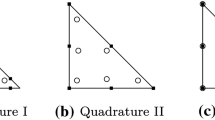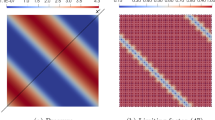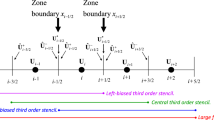Abstract
In this paper, families of flux-continuous, locally conservative, finite-volume schemes are presented for solving the general geometry-permeability tensor pressure equation on structured and unstructured grids in two and three dimensions. The schemes are applicable to the general tensor pressure equation with discontinuous coefficients and remove the O(1) errors introduced by standard reservoir simulation (two-point flux) schemes when applied to full anisotropic permeability tensor flow approximation (Edwards and Rogers in Multigrids Methods, vol. 1, pp. 190–200, 1993; Edwards and Rogers in Proceedings: 4th European Conference on the Mathematics of Oil Recovery, 1994; Edwards and Rogers in Comput. Geom. 2:259–290, 1998). Full tensors arise when the local orientation of the grid is non-aligned with the principal axes of the tensor field. Full tensors may also arise when fine scale permeability distributions are upscaled to obtain gridblock-scale permeability distributions. In general full tensors arise when using any structured or unstructured grid type that departs from K-orthogonality.
A family of schemes is quantified by a quadrature parametrization q, where the position of continuity defines the quadrature and hence the family.
This paper presents complete extensions of the q-families of control-volume distributed (CVD) multi-point flux approximation (MPFA) flux-continuous schemes for general three dimensional grids comprised of classical element types, hexahedra, tetrahedra, prisms and pyramids. Discretization principles are presented for each element. The pyramid element is shown to be a special case with unique construction of the continuity conditions. The Darcy flux approximations are applied to a range of test cases that verify consistency of the schemes.
A series of numerical test cases are presented and numerical convergence studies are conducted for the q-families of schemes, using different types of two and three dimensional structured and unstructured grids. Use of quadrature parametrization is investigated and specific quadrature points are observed to yield improved convergence for the families of flux-continuous schemes on structured and unstructured grids in two and three dimensions.
When applying the CVD(MPFA) schemes to strongly anisotropic heterogeneous media they can fail to satisfy a maximum principle as with other finite element and finite-volume methods, (M-matrix conditions are given in (Edwards and Rogers in Proceedings of the 4th European Conference on the Mathematics of Oil Recovery, 1994; Edwards and Rogers in Comput. Geom. 2:259–290, 1998; Edwards in 13th SPE Reservoir Simulation Symposium, pp. 553–562, 1995; Edwards et al. Quasi-montonic variable support (q1,q2) families of continuous darcy-flux cvd(mpfa) finite volume schemes, 2006; Edwards and Zheng in J. Comput. Phys. 227:9333–9364, 2008) and for high (full-tensor) anisotropy ratios they can yield numerical pressure solutions with spurious oscillations. In this work methods for obtaining optimal discretization with minimal spurious oscillations are also investigated. New flux-splitting techniques based on (Edwards in J. Comput. Phys. 160:1–28, 2000) are also developed so as to impose a discrete maximum principle, the new methods prove to be effective for problems with high anisotropy ratios (Pal and Edwards in Proceedings of the 10th European Conference on the Mathematics of Oil Recovery, 2006; Pal and Edwards in Proceedings of the ECOMASS CFD-2006 Conference, 2006). In all cases the resulting numerical pressure solutions are free of spurious oscillations.
Similar content being viewed by others
References
Edwards MG, Rogers CF (1993) Multigrid and renormalization for reservoir simulation. In: Hemker, Wesseling (eds) Multigrids methods, vol 1. Birkhauser, Basel, pp 190–200
Edwards MG, Rogers CF (1994) A flux continuous scheme for the full tensor pressure equation. In: Proceedings: 4th European conference on the mathematics of oil recovery, Norway
Edwards MG, Rogers CF (1998) Finite volume discretization with imposed flux continuity for the general tensor pressure equation. Comput Geom 2:259–290
Edwards MG (1995) Symmetric, flux-continuous positive definite approximation of elliptic full tensor pressure equation in local conservation form. SPE 291471. In: 13th SPE reservoir simulation symposium, San Antonio, TX, USA, pp 553–562
Edwards MG, Pal M, Zheng H (2006) Quasi-monotonic variable support (q1,q2) families of continuous darcy-flux cvd(mpfa) finite volume schemes. Preprint
Edwards MG, Zheng H (2008) A quasi-positive family of continuous darcy-flux finite volume schemes with full pressure support. J Comput Phys 227:9333–9364
Edwards MG (2000) M-matrix flux splitting for general full tensor discretization operator on structured and unstructured grids. J Comput Phys 160:1–28
Pal M, Edwards MG (2006) Family of flux-continuous finite-volume schemes with improved monotonicity. In: Proceedings of the 10th European conference on the mathematics of oil recovery, Amsterdam, The Netherlands
Pal M, Edwards MG (2006) Flux-splitting schemes for improved monotonicity of discrete solution of elliptic equation with highly anisotropic coefficients. In: Proceedings of the ECOMASS CFD-2006 conference. Egmond aan Zee, The Netherlands
Bear J (1989) Dynamics of fluids in porous media. Courier Dover, New York
Heinemann ZE, Brand CW, Munka M, Chen YM (1989) Modeling reservoir geometry with irregular grids. SPE 18412 presented at 10th SPE RSS, Houston, 6–8 February 1989
Heinemann ZE, Brand CW, Munka M, Chen YM (1991) Modeling reservoir geometry with irregular grids. In: SPERE, May 1991, pp 225–232
Durlofsky LJ (1991) Numerical calculation of equivalent grid block permeability tensors for heterogeneous media. Water Resour Res 27:699–708
Yanosik JL, McCracken TA (1979) A nine-point finite-difference reservoir simulation for realistic prediction of adverse mobility ratio displacements. SPE J 267:253–262
Bertiger WI, Padamanabhan L (1983) Finite difference solution to grid orientation problems using impes. In: SPE 12250 reservoir simulation symposium, San Francisco, pp 12250
Shah PC (1983) A nine-point finite difference operator for reduction of grid orientation effect. In: SPE reservoir simulation symposium, pp 12252
Edwards MG (2002) Unstructured, control-volume distributed, full tensor finite volume schemes with flow based grids. Comput Geom 6:433–452
Aavatsmark I, Barkve T, Bøe Ø, Mannseth T (1996) Discretization on non-orthogonal, quadrilateral grids for inhomogeneous, anisotropic media. J Comput Phys 127:2–14
Aavatsmark I, Barkve T, Bøe Ø, Mannseth T (1998) Discretization on unstructured grids for inhomogeneous, anisotropic media. Part I: derivation of the methods. SIAM J Sci Comput 19:1700–1716
Aavatsmark I, Barkve T, Bøe Ø, Mannseth T (1998) Discretization on unstructured grids for inhomogeneous, anisotropic media. Part II: discussion and numerical results. SIAM J Sci Comput 19:1717–1736
Aavatsmark I (2002) Introduction to multipoint flux approximation for quadrilateral grids. Comput Geom 6:405–432
Verma S (1996) PhD thesis, Stanford University
Lee SH, Tchelepi H, DeChant LJ (1999) Implementation of a flux continuous finite difference method for stratigraphic hexahedron grids. In: SPE reservoir simulation symposium, Houston, TX, USA, p SPE 51901
Lee SH, Jenny P, Tchelepi H (2002) A finite volume method with hexahedral multiblock grids for modeling flow in porous media. Comput Geom 6:353–379
Wheeler MF, Yotov I (2006) A multipoint flux mixed finite element method. SIAM J Numer Anal 44:2082–2106
Russel TF, Wheeler MF (1983) Finite element and finite difference methods for continuous flows in porous media. In: Ewing RE (ed) Mathematics of reservoir simulation. Frontiers in applied mathematics SIAM, pp 35–106
Durlofsky LJ (1993) A triangle based mixed finite element finite volume technique for modeling two phase flow through porous media. J Comput Phys 105:252–226
Wheeler MF, Arbogast T, Yotov I (1997) Mixed finite elements for elliptic problems with tensor coefficients as cell centered finite differences. SIAM J Numer Anal 34–2:828
Russell TF (1992) Relationships among some conservative discretization methods. In: Chen Z et al. (eds) Numerical treatment of multiphase flows in porous media. Lecture notes in physics, vol 552. Springer, Berlin, pp 267–282
Raviart RA, Thomas JM (1977) Lecture notes in mathematics, vol 606. Springer, New York
Farmer CL, Heath DE, Moody RO (1991) Global optimization approach to grid generation. In: SPE reservoir simulation symposium, Anaheim, CA, USA, pp 341–350
Riviere B (2000) Discontinuous Galerkin method for solving the miscible displacement problem in porous media. PhD thesis, The University of Texas at Austin
Riviere B, Wheeler MF, Banas K (2000) Discontinuous Galerkin method applied to a single phase flow in porous media. Comput Geom 49:337
Pal M, Edwards MG, Lamb AR (2006) Convergence study of a family of flux continuous, finite volume schemes for the general tensor pressure equation. Int J Numer Methods Fluids 51:1177–1203
Nordbotten JM, Aavatsmark I (2005) Monotonicity conditions for control volume methods on uniform parallelogram grids in homogeneous media. Comput Geom 9:61–72
Pal M, Edwards MG (2007) Quasi-monotonic continuous darcy-flux approximation for general 3-d grids of any element type. In: SPE reservoir simulation symposium, Houston, TX, USA
Nordbotten JM, Aavatsmark I, Eigestad GT (2007) Monotonicity of control volume methods. Numer Math 211:006–0060
Edwards MG (2002) Symmetric positive definite general tensor discretization operator on unstructured and flow based grids. In: 8th European conference on mathematics of oil recovery, Freiberg, Germany
Darcy H (1856) Les fontaines publiques de la ville de Dijon
Norman JC (1969) Elements of petroleum reservoirs. Henry L. Doherty series
Arnes JE, Gimse T, Lie K-A (2010) An introduction to the numerics of flow in porous media using Matlab: Geometrical modeling, numerical simulation, and optimization: industrial mathematics at SINTEF. Springer, Berlin
Aziz K, Settari A (1979) Petroleum reservoir simulation. Applied Science Publishers, London
Edwards MG (2003) Control-volume distributed sub-cell flux schemes for unstructured and flow based grids. In: SPE reservoir simulation symposium, Houston, TX, USA
Edwards MG, Pal M (2006) Symmetric positive definite general tensor discretization: a family of sub-cell flux continuous schemes on cell centred quadrilateral grids. In: Proceedings of the 10th European conference on the mathematics of oil recovery, Amsterdam, The Netherlands
Pal M, Edwards MG (2006) Effective upscaling using a family of flux-continuous, finite-volume schemes for the pressure equation. In: Proceedings, ACME 06 conference, Queens University Belfast, Northern Ireland, UK, pp 127–130
Friss HA, Edwards MG, Mykkeltveit J (2008) Symmetric positive definite flux-continuous full-tensor finite-volume schemes on unstructured cell centered triangular grids. SIAM J Sci Comput 31:1192–1220
Edwards MG (1998) Cross flow tensor and finite volume approximation with by deferred correction. Comput Methods Appl Mech Eng 151:143–161
Edwards MG (1996) Superconvergent renormalization and tensor approximation. In: 5th European conference on mathematics of oil recovery, Leoben, Austria, pp 445–454
Edwards MG, Pal M (2008) Positive definite q-families of continuous subcell darcy-flux cvd(mpfa) finite volume schemes and the mixed finite element method. Int J Numer Methods Fluids 57:355–387
Edwards MG (2006) Higher-resolution hyperbolic-coupled-elliptic flux continuous cvd schemes on structured and unstructured grids in 3-d. Int J Numer Methods Fluids 51:1079–1095
Becker E Carey G, Oden JT (1981) Finite elements an introduction, vol 1. Prentice Hall, Englewood Cliffs
Eigestad GT, Klausen RA (2005) On the convergence of the multi-point flux approximation o-method: numerical experiments for discontinuous permeability. Numer Methods Partial Differ Equ 21(6):1079–1098
Aavatsmark I, Eigestad GT (2006) Numerical convergence of mpfa-o and u methods on general quadrilateral grids. Int J Numer Methods Fluids 51:939–961
Mlacnik MJ, Durlofsky LJ Unstructured grid optimization for improved monotonicity of discrete solutions of elliptic equation with highly anisotropic coefficients. Submitted to Elsevier Science
Mallison BT, Nordbotten JM, Aavatsmark I, Eigestad GT (2008) A compact multipoint flux approximation method with improved robustness. Numer Methods Partial Differ Equ 24:1329–1360
Le Potier C (2005) Schema volume finis pour des operator operateurs de diffusion fortement anisotropes sur des maillages de triangle nonstructures. C R Math Acad Sci Paris, Ser I 340(12):921–926
Svyatskiy D, Lipnikov K, Shashkov M, Vassilevski Y (2008) Monotone finite volume schemes for diffusion equations on unstructured triangular and shape-regular polygonal meshes. J Comput Phys 227:492–512
Axelsson O (1994) Iterative solution methods. Cambridge University Press, Cambridge
Aadland T, Aavatsmark I, Dahle HK (2004) Performance of a flux splitting when solving the single-phase pressure equation discretized by mpfa. Comput Geom 8(4):325–340 (16)
Godlewski E, Raviart P (1996) Numerical approximation of hyperbolic systems of conservation laws. App math sci, vol 118. Springer, New York
Younes A., Fontaine V. (2008) Efficiency of mixed hybrid finite element and multi-point flux approximation methods on quadrangular grids and highly anisotropic media. Int J Numer Methods Eng 76(3):314–336
Author information
Authors and Affiliations
Corresponding author
Additional information
This work was done when the first author was a PhD Student at Swansea University, UK (2004-2007).
Rights and permissions
About this article
Cite this article
Pal, M., Edwards, M.G. q-Families of CVD(MPFA) Schemes on General Elements: Numerical Convergence and the Maximum Principle. Arch Computat Methods Eng 17, 137–189 (2010). https://doi.org/10.1007/s11831-010-9043-4
Received:
Accepted:
Published:
Issue Date:
DOI: https://doi.org/10.1007/s11831-010-9043-4




